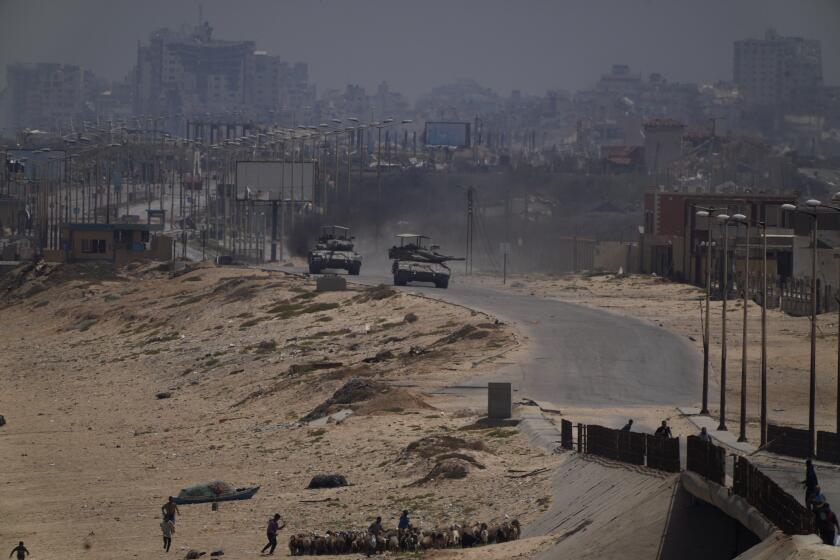U.S. Aid Funds for Afghan Rebuilding Seen as Wasted
Millions of dollars in U.S. aid money earmarked for the reconstruction of Afghanistan have been squandered through mismanagement, inefficiency and political miscalculations by the U.N. office in charge of the project, according to independent relief agencies, Afghan professionals, U.N. workers and Western diplomats.
The program was begun in October, 1988, as an ambitious, billion-dollar international effort to rebuild Afghanistan after a decade of war. Tens of millions of dollars have been spent on salaries, offices, vehicles and housing since then--but only a handful of roads, canals and villages have been repaired.
Poor accounting or no accounting has led to double-funding of projects, some of which are still unstarted. In numerous cases, money or material aid has simply been used for the wrong purpose.
In one instance, for example, funds earmarked for rebuilding a road between villages were spent instead on an illegal logging road that has further ravaged a rural area. In another, scores of oxen purchased under a U.N. project so that farmers in some areas could plow their fields again were eaten by returning refugees who had been given nothing to care for the animals.
The most controversial and costly of all the projects funded by the office of the U.N. coordinator, Prince Sadruddin Aga Khan, is a multimillion-dollar effort, financed largely by the United States, to help clear Afghanistan of millions of land mines. These continue to kill or maim people returning from refugee camps in Pakistan to areas of Afghanistan where fighting in the civil war has subsided.
The U.S. Embassy in Islamabad cited the mine-clearance program last month in a report to Washington that harshly criticized the Sadruddin operation. It said it has “produced very little in the way of substantive impact on the humanitarian side.”
A Western aid official said, “There’s really nothing they’ve done well, and the mine program is typical of their failures.”
A U.N. official who worked on the mine-clearing project called it “as scandalous as the mine fields themselves.”
The United Nations has spent nearly $3 million instructing 7,494 Afghans in mine-clearing procedure at a Pakistani army facility, but now, a year later, most of these people have disappeared. Most of the remaining trainees are still considered unqualified, and fewer than 50 have gone into Afghanistan to begin work.
“They made a very expensive mistake,” said Rae McGrath, who resigned in frustration last month as a key official in the mine-clearance program. “Rather than try to train 15,000 de-miners at a low level of competence, it would have been better to train 1,500 at a very high level.
“But the whole thing was poorly planned. They were training people, but they weren’t giving any thought to actually putting them inside Afghanistan. They just jumped in overnight and went too fast in the wrong directions.”
Western aid officials, who asked not to be identified by name, blame the impatience for quick, high-profile results on what they described as Prince Sadruddin’s ambition to become secretary general of the United Nations.
The prince’s office in Islamabad denies this. Sadruddin, a wealthy Ismailian Muslim based in Switzerland, was U.N. high commissioner for refugees for more than a decade and was personally endorsed by President Bush, a close friend, to head the Afghan program.
Shakil Khan, a retired Pakistani army major who was appointed by Sadruddin’s office to head the mine-clearance program, conceded that costly mistakes have been made.
“It is a very important and well-founded criticism,” Khan said of the charge that training funds were wasted. “But this is the first time the U.N. has taken up this kind of program. Now we have learned from mistakes, and we think the whole operation will improve this year.”
Two U.N. mine-clearance teams of 27 men each are scheduled to begin work in Afghanistan after Tuesday, and the United Nations is negotiating to buy equipment that can clear large numbers of mines in a short time.
Still, some critics insist that large-scale waste will continue in the reconstruction project because of the way it is structured, with all the major U.N. agencies working in Afghanistan under the control of Sadruddin’s office, which is thousands of miles away in Geneva.
U.S. officials, in their report last month, said: “There is not a single (U.N.) agency head in Islamabad who thinks the management approach is working, nor is there any embassy in Islamabad that will speak favorably of it. And worse, there seems to be little or no prospect for improvement.”
U.S. officials, who have run a largely successful cross-border aid project in Afghanistan for the past five years, have paid close attention to the mine-clearing program because it is financed almost entirely by the U.S. taxpayer.
They were upset when Sadruddin refused last month to use part of the mine-clearance money to fund an American project that was already under way in Afghanistan, using trained personnel and dogs that can sniff out mines.
Sadruddin said in a letter to the U.S. ambassador in Pakistan that the American project violated the dogs’ animal rights. He said mines placed by human beings should be removed by human beings.
The message, circulated throughout the aid community, provoked a furious response from international aid workers, who questioned the prince’s concern for the lives of the Afghan people being trained in mine clearance.
The $1.5-million program, which is funded separately by the U.S. Agency for International Development, has problems of its own. The dogs are from Thailand and apparently understand only Thai commands. Thai military instructors and interpreters had to be brought in for two months last summer to train the American dog handlers, who then had to train Afghans through other interpreters.
Ironically, the Thai dogs are the descendants of dogs that the U.S. Army took to Bangkok in the early 1970s, and Thai dog handlers were trained by Americans.
Aid officials explain that the U.S. Army discontinued its dog program after the Vietnam War and that the Thai dogs were the only trained animals available. U.S. officials are negotiating to buy 40 additional Thai dogs for use in Afghanistan.
“Sure, there are some problems,” one aid worker conceded, “but the dog story is really what the whole issue is about. Basically, it’s a success story, and basically Sadruddin doesn’t like it.”
Experts involved in the U.N. project agree. They are quietly disregarding the prince’s ban on using dogs, and not long ago, they committed $450,000 in U.N. money for the purchase of vehicles to carry dogs into Afghanistan to work with the U.N. teams there.
Criticism of the Sadruddin operation is not limited to the high-profile mine-clearance project. Abdullah Ali, an Afghan technocrat who joined a U.N.-financed reconstruction agency in November, said the ultimate irony is the title of the program’s director.
He said Sadruddin’s official title is “Coordinator for the United Nations in Afghanistan,” but if the program lacks anything, it is coordination.
“That’s its biggest problem,” he said. “Right now, everyone is working unsystematically.”
Ali cited the United Nations’ approval last year of an Afghan resistance commander’s request for $1 million, which he said would be used to clear a road that he said serves 30 villages in Afghanistan’s Kunar province.
“In reality,” Ali said, “never in history were there even 30 people who lived anywhere near that road. “What the commander did was reopen a road that led to one of the few forests left near the Pakistan border. He cut down all the trees and made a personal fortune.
“The problem is that no one is checking on anything, and the U.N. seems to be in a big hurry to spend all the money.”
At Sadruddin’s office in Islamabad, public relations director Rene Albreck conceded that there has been a lack of accountability in the program. He blamed it on the fact that such checking is impossible in a country still at war.
Albreck pointed to Sadruddin’s latest official position paper, entitled “Plan of Action, 1990,” and said: “The key word now is systematic. There was no systematic follow-up on anything in the past, and we would like to have more accountability.
“But much of the larger problem was based on a wrong assumption. We assumed that a million refugees would go home when the Soviets left Afghanistan last year, and the point is, nothing happened. Nobody went back. So we’ve been rethinking everything.
“There can be different types of mistakes, and in our case you can say the mistake was the miscalculation and being too optimistic.”
International aid officials, who represent scores of countries that in 1988 pledged a total of $195 million for the Afghan reconstruction effort, insist that they have been extremely costly mistakes.
“Maybe things will improve this year. Who knows?” a European aid official said. “But when you look at programs like the mines, it’s not just the money. One wonders just how many limbs and how many lives might have been saved--and might yet be saved--if only the prince could get his act together.”
More to Read
Start your day right
Sign up for Essential California for news, features and recommendations from the L.A. Times and beyond in your inbox six days a week.
You may occasionally receive promotional content from the Los Angeles Times.






